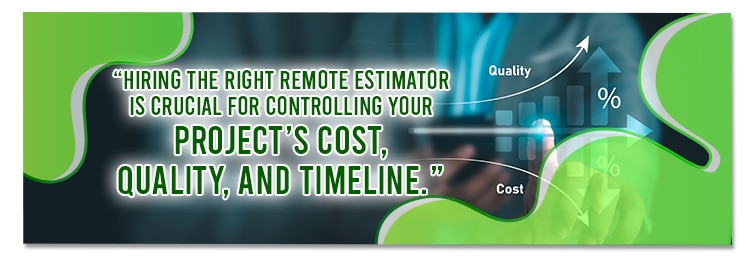Starting a new construction project?
If you want to make sure your project is accomplished on time and within budget, you’ll need the help of skilled remote estimators.
Yes, you read that right. Thanks to recent technological advances, estimators no longer need to be present on-site to do their work.
Learn more about the benefits of availing the right remote estimating services below.
Introduction to the Role of Remote Estimators in Construction
So, what do estimators bring to the table?
Here’s a brief overview of the role’s functions, the importance of finding the right one for your needs, and recent trends in estimating services.
Overview of Remote Estimator’s Functions
Like their on-site counterparts, remote estimators are responsible for calculating how much money, time, and materials are necessary to complete a project.
They utilize digital tools to analyze a project’s plan, gather price quotes, and prepare accurate construction estimates.
Remote estimators also work closely with project managers, architects, and other team members to assess risks, track costs, adjust estimates and provide reports to keep the project within budget.
Differences Between a Project Manager and an Estimator
Although they might have overlapping responsibilities, there are significant differences between project managers and estimators:
| 1. Role Focus | Project Managers:
Estimators:
|
| 2. Primary Tasks | Project Managers:
Estimators:
|
| 3. Timing of Involvement | Project Managers:
Estimators:
|
| 4. Decision-Making | Project Managers:
Estimators:
|
Importance of Hiring the Right Remote Estimator
Hiring the right remote estimator is crucial for controlling your project’s cost, quality, and timeline.
Skilled remote estimators can make accurate cost estimates by carefully calculating all potential expenses, such as materials, labor, and tools.
 Aside from cost estimation, they can also estimate the time needed to complete the project.
Aside from cost estimation, they can also estimate the time needed to complete the project.
With these estimates, you’re in a better position to allocate your resources, particularly which areas to invest in, and whether to proceed with the project as planned.
Additionally, despite working offsite, remote estimators work closely with their team by utilizing online communication tools like Skype and Zoom.
Doing so keeps everyone on the same page and allows them to address changes in the project and adjust estimates accordingly.
Trends in Remote Estimation Across the US Construction Industry
Remote estimation is becoming increasingly common today, thanks to advances in modern technology and changes in how projects are managed.
Here are some key trends in this industry:
- Adoption of Automation and Artificial Intelligence (AI) in Estimation
-
-
- AI and automation tools are streamlining most estimation processes, making them faster and more accurate.
- Many construction companies today are investing in AI tools to help analyze previous data to predict costs and identify cost-saving opportunities.
-
- Utilization of Drones and Remote Sensing
-
-
- Estimators now use drones to conduct site surveys and gather data without requiring physical visits.
- These tools provide high-quality images and data that can be used for more accurate project estimations.
-
- Integration of Building Information Modelling (BIM)
-
-
- More and more estimators use Building Information Modelling (BIM), a 3D modeling technology, to create detailed and accurate estimates.
- BIM enables better project visualization and helps identify potential threats.
-
- Increased Emphasis on Sustainability and Green Buildings
-
-
- There’s a growing demand for estimators who can accurately estimate the costs of sustainable materials and energy-efficient designs as green building practices become more popular.
-
- Cloud-Based Estimating Software
-
-
- Cloud-based software and digital tools are becoming standard for remote estimators, allowing them to access, update, and share project data anytime and anywhere.
-
- Adoption of Virtual Reality (VR) and Augmented Reality (AR) Tools
-
- Estimators use VR and AR technologies to create immersive site walkthroughs and project data overlays to visualize projects clearly and identify potential challenges.
Understanding the Role of an Estimator in the US
Here’s an in-depth look at the role estimators play in US construction services, the skills and qualifications they need, and the current demand for this job.
What Does an Estimator Do?
An estimator is responsible for assessing the total cost of construction projects. Their role involves:
- Reviewing Project Plans and Specifications
-
-
- Estimators usually start by carefully examining architectural plans, blueprints, and project specifications provided by architects, engineers, or clients.
-
- Analyzing Material and Labor Costs
-
-
- They’ll then identify all the materials needed for the project, the labor costs, and the amount of time required to complete it.
-
- Assessing Potential Risks and Contingencies
-
-
- They also identify potential risks that could affect the project and add contingency amounts to the estimate to cover them.
-
- Creating Detailed Cost Estimates
-
-
- After gathering all the necessary information, estimators then compile it into a detailed cost estimate.
- This document includes a breakdown of all costs, from materials, labor, and equipment, overhead (project management, permits, and insurance), and profit margins.
-
- Supporting Project Bidding and Budgeting
-
- Estimators play a crucial role in helping construction companies submit competitive bids for projects.
- Their estimates also serve as the basis for project budgeting, guiding financial decisions throughout the project’s life cycle.
- Collaborating With Teams:
- Estimators work with project managers, engineers, and clients to ensure estimates align with project goals and expectations.
Skills and Qualifications
When looking for estimators for your project, look for the following skills and qualifications:
- Excellent analytical skills and attention to detail,
- A bachelor’s degree in a relevant field, like construction management or civil engineering,
- Proficiency in mathematics, statistics, and data analysis,
- Report writing and strategic planning skills,
- Familiarity with analyzing requirement data to develop material and cost estimates for large projects,
- Expertise with analytic tools like spreadsheets and database managers,
- Ability to read and interpret technical documents,
- Exceptional time management skills, and
- Excellent communication and interpersonal skills.
Job Outlook and Demand
Estimators are always in high demand.
According to the US Bureau of Labor Statistics, estimators can expect a 9% growth in employment from 2018 to 2028.
Traditionally, many estimators find career opportunities in construction. However, they’re also in demand in the manufacturing and engineering industries.
Within these industries, estimators fill in various roles, like construction cost estimators, project managers, and quantity surveyors.
Benefits of Hiring Remote Estimators
Here are some of the perks of hiring remote estimators for your next construction project:
Maximizing Project Flexibility With Remote Estimators
Hiring remote estimators gives you access to a wider talent pool than you otherwise would have if you limited your search to your area.
Aside from access to top talent, you can also easily adjust the number of estimators working on a project based on its size and complexity.
 Furthermore, remote estimators can work in different time zones, speeding up your project’s progress since they can work past regular office hours.
Furthermore, remote estimators can work in different time zones, speeding up your project’s progress since they can work past regular office hours.
Cost Savings and Efficiency for Your Projects
Another benefit of hiring remote estimators is lower overhead costs compared to hiring their in-house counterparts for the same work quality.
Having access to a global talent pool also means you can hire estimators in regions with lower labor costs, giving you access to skilled professionals at an affordable rate.
Finally, with remote estimators handling cost calculations, your in-house team can focus on core project activities, leading to increased efficiency and streamlined operations.
Leveraging Advanced Technology and Tools for Accurate Estimates
Just because they can’t physically visit your project’s site doesn’t mean remote estimators can’t do their job.
Thanks to modern tools like drones and remote sensing, estimators can conduct site surveys and gather data without visiting the site in person.
Additionally, remote estimators use AI, BIM, and AR and VR tools to streamline their work and identify potential threats.
Challenges in Working With Remote Estimators
That said, working with remote estimators does come with unique challenges.
Here are some of the most common ones – and ways to overcome them.
Overcoming Communication and Collaboration Barriers
One of the most common challenges you’ll encounter when working with remote estimators is communication and collaboration difficulties.
This stems from differences in time zones, making it hard to schedule meetings and communicate in real-time with them.
Fortunately, video conferencing (Skype, Zoom) and project management tools (Clickup, Monday.com, etc.) can remedy this.
In addition, you should also schedule regular meetings so you’re both on top of important updates.
Ensuring Data Security and Confidentiality in Remote Estimations
Data privacy and security is an increasing concern in today’s highly digitalized world.
Working with remote estimators means sharing sensitive information like project costs, client details, and company strategies on the internet.
 This creates the risk of unauthorized access, leading to potential security breaches and leaks.
This creates the risk of unauthorized access, leading to potential security breaches and leaks.
Fortunately, you can overcome this by using only secure and encrypted platforms when communicating and sharing files with your estimator.
Additionally, you should require your estimator to use strong, unique passwords and multi-factor authentication (like having a code sent to their phone) before they can access sensitive information.
Common Misconceptions About What Remote Estimators Can Do
Since it’s a relatively new practice, there are many misconceptions about remote estimation.
Here are some of these misconceptions – and the truth behind them:
| Common Misconceptions About Remote Estimators: | What They Can Actually Do: |
| 1. Can’t Provide Accurate Estimates Without On-Site Visits
A common misconception is that estimators must be present on-site to do their work. After all, how could they properly assess the site if they can’t see it in person? |
Though this was true in the past, thanks to advances in technology, things are more flexible now.
By using drones and remote sensing tools, estimators can survey the site and gather data without setting foot on-site. In addition, they can also use virtual reality (VR) and augmented reality (AR) tools to visualize projects clearly and identify potential problems – even from a continent away. Finally, remote estimators use cloud-based estimating software to access, update, and share project data anytime and anywhere. |
| 2. Are Less Reliable Than On-Site Estimators
Since remote estimators aren’t on-site, many assume they’re not as reliable as traditional estimators. Concerns about communication gaps, time zone differences, and potential delays in project timelines are common reasons businesses remain hesitant to hire remote estimators. |
The truth is that many remote estimators can be just as reliable, if not more so, than their on-site counterparts.
Remote estimators often work flexible schedules, which means they can adjust their schedules to meet project deadlines, even if it means working outside business hours. Also, hiring remote estimators allows you to tap into the global talent pool and find the best one for your needs – and at a much lower cost than those in your area. |
| 3. Lack Access to the Latest Tools and Technologies
Another common misconception about remote estimators is that they don’t have as much access to vital tools and resources, thus compromising the quality of their output. |
In reality, remote workers have full access to the same, and sometimes even more advanced, tools as their on-site counterparts.
|
Industries Relying on Remote Estimators in the US
Here are the top US industries where remote estimators are greatly in demand as of this writing:
Construction Industry
Naturally, most remote estimators find employment in the construction industry.
Here, estimators help figure out the costs for building projects, particularly how much materials, labor, and tools required to complete such will cost.
Manufacturing and Production
Another notable industry that hires remote estimators is manufacturing and production.
They’re responsible for calculating the costs of producing goods like machinery, electronics, and other consumer products.
In addition, they also estimate the expenses like raw materials, labor, and production processes to ensure the products are made within budget, as well as to ensure that they’ll net a decent profit margin when sold.
Information Technology
Surprisingly, many remote estimators are also finding work in the information technology (IT) industry these days.
Here, they take on the roles of project cost estimators, business analysts, and financial analysts.
These professionals help estimate the costs and resources needed for IT projects and help IT companies make better-informed decisions as a result.
How to Select the Right Remote Estimator for Your Project
Now that you’ve gotten the lowdown on remote estimators, how do you find the right one for your next project?
Here are some tips:
Evaluating Professional Experience and Expertise
Before you start looking for a remote estimator, it’s crucial to outline what you will require of them for your project/s, such as scope, industry-specific knowledge, and technical skills.
Use these to develop your own criteria, such as years of experience, familiarity with certain technologies, or past work in similar industries.
 Once you have your criteria, look for resumes that best match it. Additionally, request and review portfolios or examples of past projects.
Once you have your criteria, look for resumes that best match it. Additionally, request and review portfolios or examples of past projects.
Verify if your applicant has any relevant certifications and/or formal training, such as a Certified Professional Estimator (CPE) or anything similar.
After short-listing the applicants, it’s time to interview them. Carefully formulate questions that assess their industry knowledge, problem-solving skills, and ability to work remotely.
One essential remote skill you should look for is strong communication skills. Thus, pay attention to how clearly and effectively they respond during the interview.
Key Factors to Consider When Hiring
When hiring a remote estimator, the following factors can help you evaluate and select the right candidate for your project:
- Relevant Industry Experience:
- Look for candidates who have worked on similar projects and have a proven track record in your field.
- Technical Skills and Proficiency:
- Ideally, they should also be skilled in using relevant estimating software (i.e. BIM, AutoCAD, and other specialized estimation tools) and other project management tools.
- Strong Communication Skills:
- Clear and effective communication is crucial for collaborating remotely and keeping all parties involved with all the pertinent project details.
- Thus, assess an applicant’s ability to explain estimates clearly, respond promptly to messages, and participate actively in virtual meetings.
- Problem-Solving Skills:
- Inquire about past experiences where the applicant successfully resolved estimation issues or handled sudden project changes.
- Reliability and References:
- Ask for references and testimonials from previous clients to gauge each candidate’s reliability and work ethic.
- Cost and Pricing Structure:
- It’s important to find an estimator whose rates fit your budget without compromising the quality of service.
- During your interview, understand their pricing model (hourly, per project, etc.) and compare it with your budget and the value they provide.
- Data Security Practices:
- Protecting your project’s sensitive information is even more crucial in a remote setup.
- Thus, ask about their data security measures, such as using encrypted communication apps and file-sharing methods.
Utilizing Industry Networks and Resources for Hiring
Another way to find the right estimator for your needs is by tapping into your industry networks and resources.
Your trusted contacts can recommend estimators they’ve previously worked with and trust, saving you time in the hiring process.
In addition, industry groups and forums can offer insights into the latest trends and skills required for estimators in your field.
 FAQ: Common Questions About Remote Estimating
FAQ: Common Questions About Remote Estimating
Here are some common questions business owners ask when hiring remote estimators for the first time:
How Does a Remote Estimator Provide Accurate Estimates Without Visiting the Site?
Remote estimators utilize drones and remote sensing tools to help conduct site surveys and gather data – even from afar.
Aside from these, they also use building information modeling (BIM) software for better project visualization and to identify potential threats.
They then utilize advanced estimating software and AI to streamline the estimation process, making them faster and more accurate.
What Assurances Do I Have Regarding the Confidentiality of My Project Details?
By hiring a remote estimator through a reliable outsourcing company like Remote Staff, you can rest assured that your project details remain confidential.
We have stipulations and security measures in place for our estimators who have access to your information.
In addition, we also offer Non-Disclosure Agreements (NDAs) as an additional layer of security.
If you require further assistance, our IT team is available to provide support.
How Do I Pay a Remote Estimator, and What are the Typical Payment Terms?
The most common payment methods used by US companies to pay remote employees include international wire transfers, online payment platforms like PayPal, and bank transfers.
However, if you hire via Remote Staff, we’ll take care of your remote estimator’s payroll for you, and you can settle the corresponding fees via an electronic funds transfer or credit card.
Once your payment clears, we’ll send the agreed-upon compensation to your estimator’s bank account on their appointed paydays.
Can I Hire a Remote Estimator for Ongoing Projects, or is it Only for One-Time Estimates?
Yes, you can.
Remote Staff accepts full-time and part-time job orders, to ensure constant access to top-notch talent once you select someone who’s proven their ability and trustworthiness. In other words, no need to repeat the entire hiring process should you require their services again.
Remote estimators are essential in ensuring your projects are accomplished on time and within budget.
However, finding the right one for your needs can be challenging and time-consuming.
Fortunately, by working with a trusted outsourcing company like Remote Staff, you’ll have no issues finding the right candidate.
Contact us today to get started.
John Carlo Pagsolingan is a carefree yet hardworking writer with aspirations of becoming a teacher in the future. He believes that remote working isn’t just a substitute; but is a legitimate alternative to face-to-face work. Learn more as he writes about the advantages of remote work and tips for aspiring remote workers.










 Zero Recruitment Fee
Zero Recruitment Fee